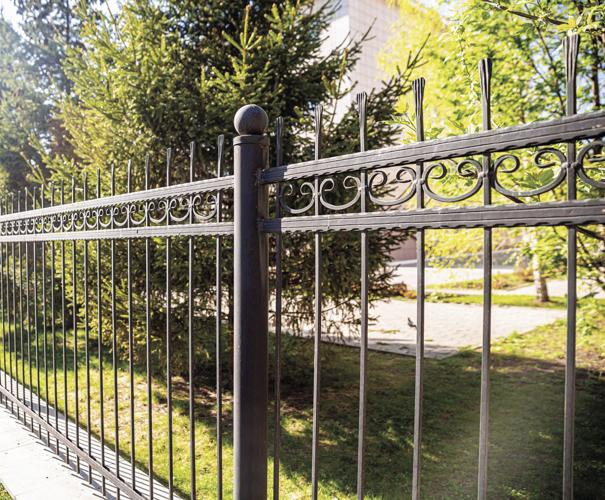All Categories
Featured
As sustainability comes to be a much more significant concern for house owners and businesses alike, discovering environment-friendly alternatives to conventional fencing products is progressively essential. From decreasing carbon impacts to saving sources, environmentally friendly secure fencing alternatives offer various environmental benefits. In this blog post, we will certainly discover a number of lasting fence materials that can help you create a resilient and eco-conscious boundary for your residential property.
![]()
Ecological Benefits: Bamboo takes in carbon dioxide and launches oxygen at a much faster price than various other plants, making it a superb option for reducing greenhouse gases. It likewise needs little to no pesticides or fertilizers, better reducing its ecological effect. Resilience: Bamboo is resistant and normally strong to parasites, degeneration, and moisture, making it an excellent fencing choice for long-term use. If appropriately treated, it can likewise endure harsh climate conditions. Visual Appeal: Bamboo supplies a classy and special look that functions well in different design schemes, consisting of exotic, Zen, and contemporary city settings. While bamboo calls for some maintenance, such as regular sealing and cleaning, it is a very lasting and fashionable selection for green fence.
Environmental Advantages: By picking recycled wood, you are assisting to minimize deforestation and prevent beneficial materials from being thrown out. Additionally, repurposing timber conserves energy that would or else be spent on generating new timber items. Durability: Recycled wood can be equally as strong and long lasting as freshly sourced wood, especially if it is properly dealt with. It may call for additional upkeep to secure it from weathering and parasites. Visual Charm: Recycled wood fences have a rustic charm and can add a special, weathered aim to your home. They can additionally be stained or repainted to fit your individual design. One factor to consider with recycled timber is that, with time, it might need even more maintenance contrasted to various other products, however its eco-friendliness makes it worth the initiative.
![]()
Environmental Advantages: Aluminum and steel can be recycled indefinitely without shedding quality. This minimizes the need for new resources and the environmental impact of steel manufacturing. Sturdiness: Steel fencings are unbelievably resilient, needing little to no maintenance with time. They are immune to the components, including uv, wind, and rainfall damage, making them durable. Aesthetic Charm: Steel fencings can be tailored in a selection of designs, from contemporary layouts to much more conventional looks. While they might not supply as much personal privacy as timber, they can be used to produce elegant, modern-day limits for your residential property. Light weight aluminum and steel fencings are best for those seeking a low-maintenance and sustainable option that still supplies an eye-catching look.
Ecological Benefits: Living fencings assist enhance air high quality by taking in carbon dioxide, and they can also sustain wild animals by offering natural environments. Furthermore, they help in reducing sound pollution and boost water retention, making them an ecologically advantageous option. Resilience: While living fencings need more upkeep (normal pruning and treatment), they can last for several years with appropriate interest. Visual Allure: A living fencing offers a beautiful and organic appearance, blending seamlessly into natural landscapes. It can give privacy and security while improving the elegance of your building. The drawback is that living fencings need more effort and time to preserve and develop, yet they offer long-term environmental benefits that much outweigh the job involved.
![]()
Ecological Benefits: Hemp grows quickly, requires little water, and requires no chemicals, making it an eco-friendly selection for fence. It likewise helps to recover soil wellness and lowers the demand for chemical fertilizers. Longevity: Hemp fencings are long lasting, durable, and immune to mold and bugs, offering reputable security for your property. Hemp fencing is still a reasonably new choice, and schedule might differ. Aesthetic Charm: Hemp fencings have a all-natural and distinct look, frequently appearing like woven floor coverings or nets, and can be utilized to produce appealing, eco-conscious borders. Hemp secure fencing is not yet as extensively readily available as other products, however it's an encouraging environmentally friendly option that is gaining grip.
Verdict: Pick Eco-Friendly Fencing for a Sustainable Future. When it pertains to selecting the appropriate fencing for your building, environment-friendly options such as bamboo, recycled wood, steel, living fences, and hemp are superb choices for those that prioritize sustainability. These materials not only add to minimizing ecological impact yet additionally provide lasting, eye-catching limits that improve your building's visual charm. Whether you're wanting to create privacy, enhance security, or simply include an aesthetic touch, environment-friendly secure fencing products provide a service that is both accountable and attractive.

- Bamboo Fencing: A Fast-Growing Renewable Resource. Bamboo is one of one of the most lasting materials available for secure fencing. Unlike conventional hardwoods, bamboo grows very promptly, with some species getting to maturity in just 3-5 years. This makes it a very renewable resource, as it can be gathered without damaging the atmosphere or the plant.
Ecological Benefits: Bamboo takes in carbon dioxide and launches oxygen at a much faster price than various other plants, making it a superb option for reducing greenhouse gases. It likewise needs little to no pesticides or fertilizers, better reducing its ecological effect. Resilience: Bamboo is resistant and normally strong to parasites, degeneration, and moisture, making it an excellent fencing choice for long-term use. If appropriately treated, it can likewise endure harsh climate conditions. Visual Appeal: Bamboo supplies a classy and special look that functions well in different design schemes, consisting of exotic, Zen, and contemporary city settings. While bamboo calls for some maintenance, such as regular sealing and cleaning, it is a very lasting and fashionable selection for green fence.
- Recycled Wood Secure Fencing: Granting Old Products New Life. Recycled timber is an additional outstanding green fencing option. Utilizing redeemed wood from old barns, pallets, or other structures can help in reducing the demand for recently gathered lumber, conserving trees and reducing waste in land fills.
Environmental Advantages: By picking recycled wood, you are assisting to minimize deforestation and prevent beneficial materials from being thrown out. Additionally, repurposing timber conserves energy that would or else be spent on generating new timber items. Durability: Recycled wood can be equally as strong and long lasting as freshly sourced wood, especially if it is properly dealt with. It may call for additional upkeep to secure it from weathering and parasites. Visual Charm: Recycled wood fences have a rustic charm and can add a special, weathered aim to your home. They can additionally be stained or repainted to fit your individual design. One factor to consider with recycled timber is that, with time, it might need even more maintenance contrasted to various other products, however its eco-friendliness makes it worth the initiative.
- Metal Fencing: Recyclable and Durable. Steel fencing, specifically aluminum and steel, is a sturdy and environment-friendly alternative. These materials can be made from recycled steels, lowering the need for mining and raw material removal, both of which are energy-intensive processes.

Environmental Advantages: Aluminum and steel can be recycled indefinitely without shedding quality. This minimizes the need for new resources and the environmental impact of steel manufacturing. Sturdiness: Steel fencings are unbelievably resilient, needing little to no maintenance with time. They are immune to the components, including uv, wind, and rainfall damage, making them durable. Aesthetic Charm: Steel fencings can be tailored in a selection of designs, from contemporary layouts to much more conventional looks. While they might not supply as much personal privacy as timber, they can be used to produce elegant, modern-day limits for your residential property. Light weight aluminum and steel fencings are best for those seeking a low-maintenance and sustainable option that still supplies an eye-catching look.
- Living Fencings: Nature's Own Barrier. Living fences, or hedges, are a green and all-natural alternative to typical secure fencing materials. These fences are made up of thick hedges, trees, or vines that expand to form a border.
Ecological Benefits: Living fencings assist enhance air high quality by taking in carbon dioxide, and they can also sustain wild animals by offering natural environments. Furthermore, they help in reducing sound pollution and boost water retention, making them an ecologically advantageous option. Resilience: While living fencings need more upkeep (normal pruning and treatment), they can last for several years with appropriate interest. Visual Allure: A living fencing offers a beautiful and organic appearance, blending seamlessly into natural landscapes. It can give privacy and security while improving the elegance of your building. The drawback is that living fencings need more effort and time to preserve and develop, yet they offer long-term environmental benefits that much outweigh the job involved.

- Hemp Fencing: Natural and Sustainable. Hemp is a environmentally friendly and fast-growing plant that can be made use of to produce sustainable fence. Hemp fibers are solid, biodegradable, and resistant to parasites and mold and mildew, making it a fantastic alternative for developing fencings.
Ecological Benefits: Hemp grows quickly, requires little water, and requires no chemicals, making it an eco-friendly selection for fence. It likewise helps to recover soil wellness and lowers the demand for chemical fertilizers. Longevity: Hemp fencings are long lasting, durable, and immune to mold and bugs, offering reputable security for your property. Hemp fencing is still a reasonably new choice, and schedule might differ. Aesthetic Charm: Hemp fencings have a all-natural and distinct look, frequently appearing like woven floor coverings or nets, and can be utilized to produce appealing, eco-conscious borders. Hemp secure fencing is not yet as extensively readily available as other products, however it's an encouraging environmentally friendly option that is gaining grip.
Verdict: Pick Eco-Friendly Fencing for a Sustainable Future. When it pertains to selecting the appropriate fencing for your building, environment-friendly options such as bamboo, recycled wood, steel, living fences, and hemp are superb choices for those that prioritize sustainability. These materials not only add to minimizing ecological impact yet additionally provide lasting, eye-catching limits that improve your building's visual charm. Whether you're wanting to create privacy, enhance security, or simply include an aesthetic touch, environment-friendly secure fencing products provide a service that is both accountable and attractive.
Latest Posts
Uncover the Premier Auto Repair Coupons in Montclare, Chicago
Published May 25, 25
1 min read
Check Out Premier Auto Repair Care offered by Montclare Auto Repair – Drive with Confidence
Published May 23, 25
1 min read
Enhance Your Building with Overhead Door Equipment
Published May 22, 25
1 min read
More
Latest Posts
Uncover the Premier Auto Repair Coupons in Montclare, Chicago
Published May 25, 25
1 min read
Check Out Premier Auto Repair Care offered by Montclare Auto Repair – Drive with Confidence
Published May 23, 25
1 min read
Enhance Your Building with Overhead Door Equipment
Published May 22, 25
1 min read